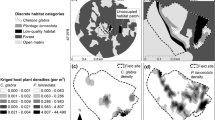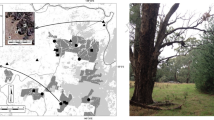Abstract
Movement underpins animal spatial ecology and is often modelled as habitat-dependent correlated random walks. Here, we develop such a model for the flightless tansy leaf beetle Chrysolina graminis moving within and between patches of its host plant tansy Tanacetum vulgare. To parameterize the model, beetle movement paths on timescales of minutes were observed in uniform plots of tansy and inter-patch matrix (meadow) vegetation. Movement lasted longer, covered greater distances and had narrower turning angles in the matrix. Simulations of the model emulated an independent two-season multi-patch mark–resight study at daily timescales and included variable boundary-mediated behaviour affecting the probability of leaving habitat patches. As boundaries in the model became stronger there were disproportionately large decreases in net displacements, inter-patch movements and the proportion of beetles in the matrix. The model produced realistic patterns of population-level displacement over periods up to 13 days with fully permeable boundaries for one dataset and strong boundaries for the other. This may be explained by the heights of the tansy patches in each study, as beetles will be unable to cross the boundary near the top of a patch that emerges from the matrix. The simulations demonstrate the important effects of boundary behaviour on displacement patterns and indicate temporal and spatial variability in permeability. Realistic models of movement must therefore include behaviour at habitat boundaries.






Similar content being viewed by others
References
Aars J, Johannesen E, Ims RA (1999) Demographic consequences of movements in subdivided root vole populations. Oikos 85:204–216
Bach CE (1988) Effects of host plant patch size on herbivore density: underlying mechanisms. Ecology 69:1103–1117
Banks JE, Yasenak CL (2003) Effects of plot vegetation diversity and spatial scale on Coccinella septempunctata movement in the absence of prey. Entomol Exp Appl 108:197–204
Batschelet E (1981) Circular statistics in biology. Academic Press, London
Bowler DE, Benton TG (2005) Causes and consequences of animal dispersal strategies: relating individual behaviour to spatial dynamics. Biol Rev 80:205–225
Bowne DR, White HR (2004) Searching strategy of the painted turtle Chrysemys picta across spatial scales. Anim Behav 68:1401–1409
Chapman DS (2006) Spatial ecology of the tansy beetle Chrysolina graminis. PhD thesis, University of York, York
Chapman DS, Sivell D, Oxford GS, Dytham C, Key R (2006) Ecology of the tansy beetle (Chrysolina graminis) in Britain. Naturalist 131:41–54
Chapman DS, Dytham C, Oxford GS (2007) Modelling population redistribution in a leaf beetle: an evaluation of alternative dispersal functions. J Anim Ecol 76:36–44
Clobert J, Ims RA, Rousset F (2004) Causes, mechanisms and consequences of dispersal. In: Hanski I, Gaggiotti OE (eds) Ecology, genetics, and evolution of metapopulations. Elsevier, Burlington, Mass., pp 307–336
Englund G, Hambäck PA (2004) Scale-dependence of emigration rates. Ecology 85:320–327
Goodwin BJ, Fahrig L (2002) How does landscape structure affect landscape connectivity? Oikos 99:552–570
Grimm V, Railsback SF (2005) Individual-based modeling and ecology. Princeton University Press, Princeton, N.J.
Grimm V, Revilla E, Berger U, Jeltsch F, Mooij WM, Railsback SF, Thulke H, Weiner J, Wiegand T, DeAngelis DA (2005) Pattern-oriented modelling of agent-based complex systems: lessons from ecology. Science 310:987–991
Hannunen S (2002) Vegetation architecture and the redistribution of insects moving on the plant surface. Ecol Model 155:149–157
Haynes KJ, Cronin JT (2006) Interpatch movement and edge effects: the role of behavioral responses to the landscape matrix. Oikos 113:43–54
Johnsen ID, Bourchier RS, Roland J (2001) The influence of matrix habitat on Apthona flea beetle immigration to leafy spurge patches. Oecologia 127:287–294
Kareiva PM (1985) Finding and losing host plants by Phyllotreta: patch size and surrounding habitat. Ecology 66:1809–1816
Kareiva PM, Shigesada N (1983) Analyzing insect movement as a correlated random walk. Oecologia 56:234–238
Kindvall O (1999) Dispersal in a metapopulation of the bush cricket, Metrioptera bicolor (Orthoptera; Tettigoniidae). J Anim Ecol 68:172–185
Lima SL, Zollner PA (1996) Towards a behavioral ecology of ecological landscapes. Trends Ecol Evol 11:131–135
Mooij WM, DeAngelis DL (2003) Uncertainty in spatially explicit animal dispersal models. Ecol Appl 13:794–805
Morales JM (2002) Behavior at habitat boundaries can produce leptokurtic movement distributions. Am Nat 160:531–538
Morales JM, Ellner SP (2002) Scaling up animal movements in heterogeneous landscapes: the importance of behavior. Ecology 83:2240–2247
Morales JM, Haydon DT, Frair J, Holsinger KE, Fryxell JM (2004) Extracting more out of relocation data: building movement models as mixtures of random walks. Ecology 85:2436–2445
Nolet BA, Mooij WM (2002) Search paths of swans foraging on spatially autocorrelated tubers. J Anim Ecol 71:451–462
Ovaskainen O, Cornell SJ (2003) Biased movement at boundary and conditional occupancy times for diffusion processes. J Appl Probab 40:557–580
Oxford GS, Sivell D, Dytham C, Key R (2003) The jewel of York—ecology and conservation of the tansy beetle. Br Wildl 14:332–337
Phillips ML, Clark WR, Nusser SM, Sovada MA, Greenwood RJ (2004) Analysis of predator movement in prairie landscapes with contrasting grassland composition. J Mammal 85:187–195
Revilla E, Wiegand T, Palomares F, Ferreras P, Delibes M (2004) Effects of matrix heterogeneity on animal dispersal. Am Nat 164:130–153
Ronce O, Olivieri I (2004) Life history evolution in metapopulations. In: Hanski I, Gaggiotti OE (eds) Ecology, genetics, and evolution of metapopulations. Elsevier, Burlington, Mass., pp 227–257
Ross JA, Matter SF, Roland J (2005) Edge avoidance and movement of the butterfly Parnassius smintheus in matrix and non-matrix habitat. Landsc Ecol 20:127–135
Schooley RL, Wiens JA (2003) Finding habitat patches and directional connectivity. Oikos 102:559–570
Schtickzelle N, Baguette M (2003) Behavioural responses to habitat patch boundaries restrict dispersal and generate emigration–patch area relationships in fragmented landscapes. J Anim Ecol 72:533–545
Sivell D (2003) The ecology and conservation of the tansy beetle Chrysolina graminis. PhD thesis, University of York, Yorl
Skalski GT, Gilliam JF (2003) A diffusion-based theory of organism dispersal in heterogeneous populations. Am Nat 161:441–458
Stamps JA, Buechner M, Krishnan VV (1987) The effects of edge permeability and habitat geometry on emigration from patches of habitat. Am Nat 129:533–552
Stevens VM, Polus E, Wesselingh RA, Schtickzelle N, Baguette M (2004) Quantifying functional connectivity: experimental evidence for patch-specific resistance in the natterjack toad (Bufo calamita). Landsc Ecol 19:829–842
Turchin PB (1986) Modeling the effect of host patch size on Mexican bean beetle emigration. Ecology 67:124–132
Turchin PB (1998) Quantitative analysis of movement: measuring and modeling population redistribution in animals and plants. Sinauer, Sunderland, Mass.
Turner MG, Dale VH, Gardner RH (1989) Predicting across scales: theory development and testing. Landsc Ecol 3:245–252
White GC, Burnham KP (1999) Program MARK: survival estimation from populations of marked animals. Bird Study 46S:120–138
Wiegand T, Jeltsch F, Hanski I, Grimm V (2003) Using pattern-oriented modelling for revealing hidden information: a key for reconciling ecological theory and application. Oikos 100:209–222
Wiens JA, Schooley RL, Weeks RD Jr (1997) Patchy landscapes and animal movement: do beetles percolate? Oikos 78:257–264
Wolfinger R, O’Conell M (1993) Generalized linear mixed models: a pseudo-likelihood approach. J Stat Comput Simul 48:233–243
Zollner PA, Lima SL (1999) Search-strategies for landscape-level interpatch movements. Ecology 80:1019–1030
Acknowledgements
Duncan Sivell performed the 2003 mark–recapture study, funded by the British Ecological Society SEPG no. 2015 awarded to G. S. O. and C. D. D. S. C. was supported by a NERC Case studentship with English Nature, from whom we thank Roger Key. We are also indebted to the City of York Council for financial support as part of their Biodiversity Action Plan. Mark Williamson, Wolf Mooij and an anonymous reviewer provided valuable comments on an earlier draft of this manuscript.
Author information
Authors and Affiliations
Corresponding author
Additional information
Communicated by Wolf Mooij.
Electronic supplementary material
Below is the link to the electronic supplementary material.
Rights and permissions
About this article
Cite this article
Chapman, D.S., Dytham, C. & Oxford, G.S. Landscape and fine-scale movements of a leaf beetle: the importance of boundary behaviour. Oecologia 154, 55–64 (2007). https://doi.org/10.1007/s00442-007-0806-z
Received:
Accepted:
Published:
Issue Date:
DOI: https://doi.org/10.1007/s00442-007-0806-z




